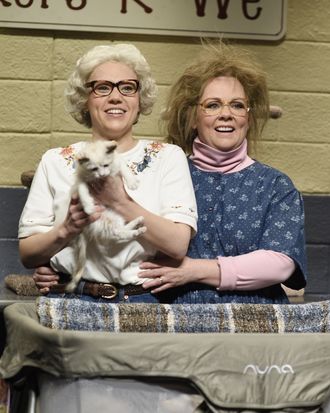
“A cat is a treasure you hold with your heart … Cats have paws, claws, and zero flaws,” begins a Saturday Night Live “commercial” for “Whiskers R We,” starring a sanguine, white-haired cat rescuer named Barbara DeDrew.
Wearing turtleneck sweaters and pleated pants, DeDrew — played by Kate McKinnon — and a rotating cast of girlfriends and former flings revel in their co-dependent tendencies and love of bad puns, while extolling the virtues and forgiving the flaws of abandoned cats. The women are fundamentally uncool, but there is poetry in their devotion: “A cat is a friend you didn’t know you needed. A cat is an itch that scratches you.”
DeDrew’s adoration of cats represents one of the most enduring lesbian clichés out there. These women mention their cats by name in their work bios and write poetry from their cats’ perspective. Their cats sign their holiday cards. They are lesbian cat lovers, an often disturbing, sometimes endearing, caricature of women who love these pets almost as much as each other — and infinitely more than they love anyone else.
Most women assiduously avoid the “cat lady” label, but lesbians have embraced the association. While the rest of the world cringed and laughed, this stereotype of fierce love for cats has helped queer and gay women build community and visibility for nearly 50 years.
Many queer women and lesbians will take every opportunity to talk publicly about their cats. Zoie Palmer from Lost Girl has a cat who tweets. Jane Lynch narrated a documentary for National Geographic about a lady with 700 cats. Talking to Jennifer Aniston on The Tonight Show, Portia de Rossi said the only thing that annoys her about wife Ellen DeGeneres is when “just as I put [dinner] down in front of her, she gets up and feeds the cats — every single night.” The couple have three cats, and DeGeneres celebrates “Cat Week” every year on her show. “If it were up to me I would have ‘Cat Month,’” she told Jay Leno on a different episode of The Tonight Show.
Like all stereotypes, the belief that the bond between lesbians and cats transcends genus and species is rooted in legend as much as truth. Lots of lesbians care about dogs (or rats, or birds, or donkeys, for that matter) more than cats. There are even lesbians who (gasp!) hate cats. The quintessential “crazy cat lady” of film and TV is not lesbian-identified, and plenty of straight people and gay men are devoted to their feline friends.
But it is no accident that Jane Lynch narrated a documentary for National Geographic about a lady with 700 cats. There’s a reason I expect interviews with celebrity lesbians to mention a cat at some point. Lesbians on the internet are obsessed with Holiday, a bug-eyed grey kitten Sara Quin from Tegan and Sara adopted last summer. In 2011, Quin told Spin that her cat, Taya, “stole my heart. She was loyal and protective of me. The other cats living in my house ignored you indiscriminately and their affections were desperate. Not my Taya.”
A cat and a vagina are both a “pussy,” but this doesn’t fully explain the magnetism and appeal. While the word “puss” has been a term for cat since the 16th century, the association between women and cats predates the use of the word as slang for vagina, which probably started sometime in the 18th century. Lesbian periodicals of the 1970s frequently blurred the lines between human and animal. Cartoons of cats watching lovers in bed, basking in patches of sunshine, or chatting at the dinner table with their humans show up in newsletters like “Out and About,” “So’s Your Old Lady,” and “Lesbian Tide.” The May 1976 issue of FOCUS: A Journal for Gay Women, announced that “Agnes Cox, well known wanton female of southern N.H. is preparing to give birth to her third group of illegitimate children.” An update on Agnes the following month reports that she “chose to awaken her people in the middle of the night and have her kittens in bed with them.”
When women were first organizing and identifying as capital-“L” lesbians en masse in the 1960s and 1970s they often looked to female-dominated or goddess-worshipping cultures as models for how to live and thrive outside patriarchal Western society. In Ancient Egypt, the cat goddess Bastet gave blessings and offered love and domestic security, while Sekhmet, her parallel deity, brought disease and sometimes attacked the things she was supposed to protect. Wicca and witchcraft — which have featured cats as companions in spiritual matters and in persecution for hundreds of years — appeal to women generally disgusted by the demands of marriage, gender roles, or mainstream femininity. And in the 1970s, few women were more disgusted with the sexist status quo than lesbian feminists.
Throughout history, cats have been goddesses, but also underhanded (“catty”). They’re sexual (“sex kitten”), but free-spirited (“a cool cat”). “Cats make me think of domesticity and comfort and home and companionship, but we can also think of cats as feral and wild, self-sufficient and independent. They’re the huntress,” says Jenna Danchuk, a witch and Ph.D student at York University who studies feminism in witchcraft communities.
For 20th-century lesbians trying to carve out a place for themselves, the domestic huntress made for a very appealing contradiction. “The independence of cats is one of the main parallels between cats and lesbians — women who simply in being lesbians declare themselves untamed in at least some small way,” writes Shoney Sien in the introduction to the 1991 anthology Dykes (and Their Cats).
Women may even seek to emulate cats’ ability to exist contentedly outside the patriarchy. “There is something between cats and women that is not based on domination or condescending adoration,” writes Sien’s co-editor, oral historian Irene Reti. “Cat is telling us about independent grace, beauty born of self-respect and pride. Cat knows how to say when she doesn’t want to be touched. Cat knows how to ignore men. It is no accident that lesbian feminists remember, even unconsciously, who our wise and sacred companions are. We who are not afraid to be called dykes, witches, crones or hags, are also friends of cats.” Rejecting the idea that humans are inherently superior to cats means rejecting other hierarchies. (To be fair, this has historically been more of a dream than a reality. That some lesbian feminists deified their cats while ostracizing and excluding women who were transgender, did sex work, or enjoyed BDSM sex makes clear how much better cats are at equality.)
Still, the cat-loving queer woman is onto something. When lesbians talk about their relationship to cats, “they root themselves within the natural world and also identify with persecution and exclusion. The cat lady says a women can be fine outside the patriarchy,” says Katie Barak, who wrote her Ph.D dissertation on the cat-lady stereotype. And only a woman who feels really and truly fine outside the patriarchy could eroticize Birkenstocks and a leather-clad Gina Gershon (who is apparently not a lesbian, but who did write an entire album about the time her cat Cleo ran away, produced by Linda Perry, who is definitely a lesbian).
An assumption of asexuality, the belief that a woman could only be this interested in cats if she was equally uninterested in sex, also drives the stereotype. In April, writer and poet Anna Pulley published The Lesbian Sex Haiku Book (With Cats!). Pulley has written haikus about all manner of queer women’s rituals — processing, listening to Tracy Chapman, having strap-on sex, eating vegan desserts. There are sections on “U-hauling,” being friends with exes, and “how lesbian sex works.” Pulley’s girlfriend, the artist Kelsey Beyer, decided to illustrate the book with drawings of cats embodying these stereotypes after Pulley showed her videos of Maru, the internet cat who dives into boxes. “A pussy diving into a box!” Pulley says. “It was too perfect of a connection.”
Pulley invokes these stereotypes intentionally and with love and humor. (“More realistic ways to ‘flag’ as a womyn-loving wo’moon: Do not brush off the / cat (or dog) hair you are most surely covered in.”) Though her landlord tragically does not allow pets, Pulley says she still embodies “a great many lesbian stereotypes.” She owns a pickup truck and lots of flannel, vests, bow ties and beanies. She’s worked at nonprofits, was a vegetarian for a decade, and fetishizes librarians, libraries and books. “So it was fun to make fun of myself in the process,” she says.
Like the editors and contributors to Cats (and Their Dykes) and Kate McKinnon on Saturday Night Live, The Lesbian Sex Haiku Book (With Cats!) manages to reflect lesbian lives even as it caricatures them. “As outsiders, we get to be ‘in’ for once,” Pulley says. “In on the joke, in on the community. And not to be too ‘serious lesbian,’ but I think that’s important.”
So when Barbara DeDrew cuddles with Harissa — a British short-haired cat who uses the “loo-ter box” — or strokes BoBo — who is “maybe definitely an alien” — while rebuffing her latest fling’s gentle groping, is she a pathetic spinster with a psychological condition or an independent elderly woman who has built her life and relationships around her passion for cat rescue? People are laughing at Barbara DeDrew, but Barbara DeDrew and her bottomless container of mewling cats are unflappable and unashamed. Like the best lesbians, deviants, and failed women, she doesn’t care if you like her, or want her, or even talk to her. She would appreciate it, however, if you’d take home this bag of cats.
Things you buy through our links may earn Vox Media a commission




